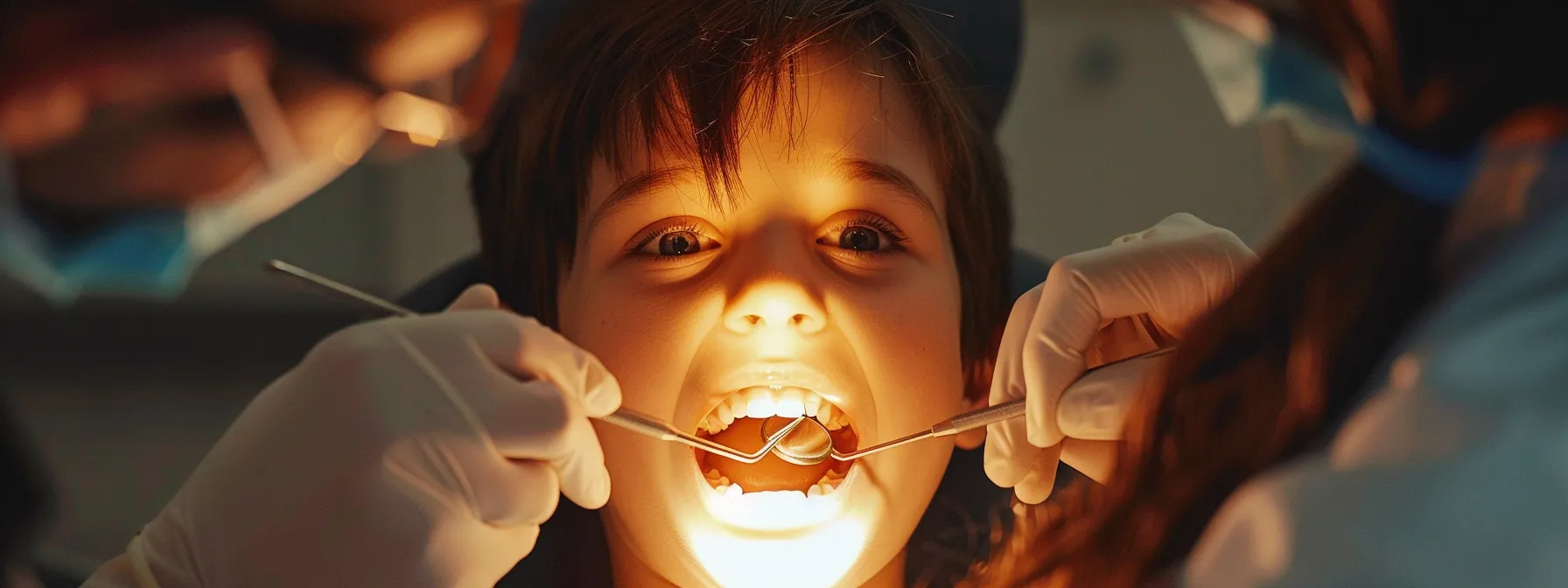
How Early Orthodontic Intervention Can Benefit Your Child
Early orthodontic intervention can profoundly impact a child’s dental health and overall well-being. A top orthodontist near me can address various issues, from misaligned incisors to temporomandibular joint problems, before they become more severe. Orthodontists utilize advanced techniques to guide proper jaw development, correct bite issues, and ensure optimal tooth alignment during a child’s formative years. In this article, we explore the numerous benefits of early orthodontic treatment and how it can set the foundation for a lifetime of healthy smiles.
Key Takeaways
- Early orthodontic intervention improves oral hygiene and reduces the risk of cavities and gingivitis
- Addressing dental issues early prevents premature wear on teeth and reduces the chance of injuries
- Early intervention promotes proper jaw development and enhances facial aesthetics
- Correcting bite problems early prevents future chewing and speaking difficulties
- Early orthodontic care extends the life of natural teeth and simplifies future dental treatments
Improve Ease of Brushing and Flossing

Early orthodontic intervention addresses dental alignment issues, making it easier for children to maintain proper oral hygiene. By correcting misaligned teeth and jaw problems, orthodontic treatment reduces the risk of developing cavities and gingivitis. This proactive approach, often recommended by top orthodontist near me dental clinics, simplifies the cleaning process for young children who may struggle with brushing and flossing. Additionally, early intervention can help prevent the need for more invasive procedures, such as surgery, later in life. It also addresses habits like thumb sucking, which can contribute to orthodontic problems if left unchecked.
Early Intervention Promotes Better Oral Hygiene
Early orthodontic intervention promotes better oral hygiene by addressing dental alignment issues before they become more severe. This proactive approach in orthodontics allows for easier cleaning of teeth and gums, reducing the risk of periodontal disease and potentially avoiding the need for dentures later in life.
Children who receive early orthodontic treatment often develop better oral hygiene habits, as properly aligned teeth are easier to brush and floss. This investment in early intervention can prevent more complex issues that might require metal braces or other extensive treatments in the future, ultimately leading to improved long-term oral health.
Simplified Cleaning Process for Young Children
Early orthodontic intervention simplifies the cleaning process for young children by addressing dental misalignments. This proactive approach, recommended by institutions like the Cleveland Clinic, reduces the risk of oral injury and makes it easier for children to maintain proper oral hygiene.
With improved dental alignment, children experience less stress when brushing and flossing, leading to better oral health habits. Proper breathing techniques can also be addressed during early intervention, further contributing to overall oral health and simplifying the cleaning process for young patients.
Reduces Risks of Cavities and Gingivitis
Early orthodontic intervention reduces the risks of cavities and gingivitis by improving tooth alignment. Properly aligned teeth create fewer hard-to-reach areas where plaque can accumulate, making tooth brushing more effective. This enhanced oral hygiene leads to a decreased likelihood of tooth decay and gum inflammation.
Dental braces and other orthodontic treatments also improve chewing function, which stimulates saliva production. Increased saliva flow helps neutralize acids in the mouth, further protecting against cavities and promoting overall oral health.
Proper brushing and flossing techniques protect more than just gum health. They also play a crucial role in safeguarding teeth against potential damage.
Help Prevent Tooth Damage

Early orthodontic intervention plays a crucial role in preventing tooth damage, offering significant benefits for children’s oral health and quality of life. By addressing potential issues during a child’s developmental years, orthodontists can prevent premature wear on teeth and reduce the chances of dental injuries. This proactive approach, which often includes a comprehensive evaluation, not only improves teeth cleaning practices but also contributes to the overall success of future cosmetic dentistry procedures. The long-term advantages of early orthodontic treatment extend beyond aesthetics, promoting optimal oral function and reducing the risk of complications later in life.
Prevents Premature Wear on Children’s Teeth
Early orthodontic intervention prevents premature wear on children’s teeth by addressing misalignments and bite issues. Orthodontic care during a child’s developmental years reduces the stress placed on teeth from improper positioning, minimizing enamel erosion and potential chipping or cracking.
Parents who book an appointment at an orthodontic office for their children can expect a comprehensive evaluation of their child’s oral hygiene and bite patterns. This proactive approach ensures that potential issues are identified and addressed early, preserving the integrity of the child’s teeth and reducing the need for extensive dental work in the future.
Reduces Chances of Dental Injuries
Early orthodontic intervention significantly reduces the chances of dental injuries by correcting misaligned teeth and improving bite patterns. Children with properly aligned teeth are less likely to experience traumatic impacts during falls or sports activities, protecting their smile and overall oral health.
Correcting dental issues early also enhances a child’s ability to brush effectively, promoting better hygiene habits. This improved oral care routine ensures teeth receive proper nutrients and protection, reducing the risk of weakened enamel and making them more resistant to potential injuries.
Tooth damage prevention sets the foundation for a healthy smile. Yet, some dental issues require more targeted solutions, leading us to explore the world of correcting misalignment.
Correct Misalignment

Early orthodontic intervention plays a crucial role in correcting misalignment issues before they escalate. The American Association of Orthodontists recommends evaluating children by age seven to identify potential problems. Addressing misalignment early can prevent complications such as wear on teeth, pain during chewing, and difficulties with digestion. Proper jaw development, facilitated by timely intervention, ensures optimal oral function and reduces the risk of malnutrition due to eating difficulties. By tackling these issues proactively, parents can safeguard their child’s long-term oral health and overall well-being.
Addresses Issues Before They Become Severe
Early orthodontic intervention addresses misalignment issues before they escalate, preventing excessive tooth wear and potential tooth loss. By identifying and treating problems early, orthodontists can guide jaw development and minimize the need for extensive treatments later in life.
Parents who request appointments for their children at a young age enable orthodontists to implement preventive measures, such as custom retainers, to correct minor issues. This proactive approach reduces the risk of severe misalignments and associated complications, ensuring optimal oral health as children grow.
Promotes Proper Jaw Development
Early orthodontic intervention promotes proper jaw development by addressing misalignment issues before they become severe. Orthodontists use techniques like clear aligners to guide bone growth and ensure optimal mouth function, potentially avoiding the need for orthognathic surgery later in life.
Proper jaw development not only improves oral health but also enhances facial aesthetics. By addressing jaw alignment early, children can achieve a balanced facial structure and avoid complications associated with misaligned jaws, such as difficulty chewing or speaking.
Misalignment correction sets the stage for a stunning smile transformation. Now, let’s explore how to achieve perfectly straight teeth for a truly captivating grin.
Straighten Teeth

Early orthodontic intervention offers a proactive approach to straightening teeth, addressing malocclusion before it becomes more severe. Parents who book appointments for their children can prevent tooth decay and improve overall oral health. While some may view orthodontic treatment as mere advertising for cosmetic purposes, it plays a crucial role in proper dental development. Many insurance plans now cover early intervention, making it more accessible for families. This approach not only enhances a child’s smile but also aids in uniform teeth growth, setting the foundation for a lifetime of confidence and optimal oral function.
Enhances Smile and Boosts Confidence
Early orthodontic intervention enhances a child’s smile and boosts confidence by addressing dental misalignments at a young age. Correcting issues like crossbite not only improves aesthetics but also prevents bacteria accumulation, protecting tooth enamel and overall oral health.
Orthodontic therapy during childhood can have a profound impact on a child’s self-esteem and social interactions. As teeth straighten and align properly, children often experience increased confidence in their appearance, which can positively influence various aspects of their lives:
- Improved social interactions
- Enhanced academic performance
- Increased participation in extracurricular activities
- Better overall mental health
- Greater willingness to smile and express themselves
Aids in Uniform Teeth Growth
Early orthodontic intervention aids in uniform teeth growth by guiding the development of permanent teeth. This proactive approach allows orthodontists to use advanced technology to monitor and influence the growth patterns of a patient‘s teeth, ensuring they emerge in proper alignment.
By addressing potential issues early, orthodontic intervention promotes healthier gums and creates an optimal environment for uniform tooth growth. This approach can prevent overcrowding, gaps, and other alignment issues that may arise as permanent teeth emerge, leading to better long-term oral health outcomes:
- Proper spacing for incoming permanent teeth
- Reduced risk of impacted teeth
- Improved bite alignment
- Enhanced facial symmetry
- Decreased likelihood of future orthodontic complications
Straight teeth transform more than just smiles. They reshape entire faces, enhancing natural beauty in remarkable ways.
Enhance Facial Aesthetics

Early orthodontic intervention plays a crucial role in enhancing facial aesthetics, contributing to balanced facial symmetry and influencing a positive self-image from a young age. By addressing dental and jaw misalignments early, orthodontists can guide facial growth, potentially preventing issues like sleep apnea and other related diseases. This proactive approach not only improves a child’s appearance but also sets the foundation for long-term oral health and overall well-being.
Contributes to Balanced Facial Symmetry
Early orthodontic intervention contributes to balanced facial symmetry by addressing dental and jaw misalignments during a child’s developmental years. Orthodontists use advanced techniques to guide facial growth, ensuring proper alignment of the jaw, teeth, and facial features.
This proactive approach can prevent asymmetrical facial development, which may result from untreated malocclusions or skeletal discrepancies. By promoting balanced facial growth, early orthodontic intervention enhances overall facial aesthetics and can positively impact a child’s self-esteem throughout their life.
Influences Positive Self-Image Early On
Early orthodontic intervention influences a positive self-image by addressing dental issues during a child’s formative years. As children develop a straighter smile and improved facial aesthetics, they often experience increased confidence and self-esteem.
This boost in self-image can have far-reaching effects on a child’s social interactions, academic performance, and overall mental well-being. By addressing orthodontic concerns early, parents provide their children with the tools to navigate social situations with greater ease and self-assurance.
Facial aesthetics extend beyond skin-deep beauty. A radiant smile with perfectly aligned teeth completes the picture of facial harmony.
Align Teeth Symmetry
Early orthodontic intervention plays a crucial role in aligning teeth symmetry, setting the foundation for a balanced and aesthetically pleasing smile. By addressing dental issues during a child’s developmental years, orthodontists can guide the growth and positioning of teeth, ensuring even spacing and alignment. This proactive approach not only improves the overall appearance of the smile but also contributes to the formation of a harmonious dental arch. As children’s jaws and facial structures continue to develop, early intervention allows for more efficient and effective correction of misalignments, potentially reducing the need for extensive treatments later in life.
Encourages Even Spacing and Alignment
Early orthodontic intervention encourages even spacing and alignment of teeth by addressing issues during a child’s developmental stages. Orthodontists utilize various techniques to guide tooth eruption and jaw growth, promoting optimal spacing between teeth and ensuring proper alignment within the dental arch.
This proactive approach prevents overcrowding and reduces the likelihood of impacted teeth, which can lead to more complex orthodontic issues later in life. By focusing on even spacing and alignment early on, children can achieve a more balanced and functional bite, setting the foundation for long-term oral health and aesthetics.
Leads to a Harmonious Dental Arch
Early orthodontic intervention leads to a harmonious dental arch by guiding the growth and development of a child’s teeth and jaw. Orthodontists use various techniques to ensure that teeth erupt in proper alignment, creating a balanced and aesthetically pleasing dental arch.
A harmonious dental arch contributes to improved oral function, including better chewing efficiency and speech clarity. This early intervention can prevent the need for more extensive treatments later in life, such as extractions or jaw surgery, by addressing potential issues before they become more severe:
- Proper tooth alignment
- Balanced bite force distribution
- Enhanced facial symmetry
- Improved speech articulation
- Reduced risk of temporomandibular joint disorders
Straight teeth shine brilliantly, but a perfect smile goes beyond mere aesthetics. Correcting bite issues unlocks a world of oral health benefits and boosts overall well-being.
Fix Bite Problems

Early orthodontic intervention plays a crucial role in addressing bite problems before they become more severe. By detecting and correcting issues such as overbites, underbites, and crossbites at an early age, orthodontists can guide proper jaw development and tooth alignment. This proactive approach not only improves the aesthetics of a child’s smile but also prevents potential complications in chewing and speaking later in life. Early intervention allows for more effective treatment options and can reduce the need for extensive orthodontic work as the child grows older.
Early Detection and Correction of Bite Issues
Early detection and correction of bite issues through orthodontic intervention can prevent more severe problems in the future. Orthodontists use advanced diagnostic tools to identify malocclusions, such as overbites, underbites, and crossbites, in young children.
Timely treatment of these bite issues can guide proper jaw development and tooth alignment, reducing the need for extensive orthodontic work later in life. The following table outlines common bite problems and their potential consequences if left untreated:
Prevents Future Chewing and Speaking Problems
Early orthodontic intervention prevents future chewing and speaking problems by addressing bite issues during a child’s developmental years. Correcting malocclusions, such as overbites and underbites, ensures proper alignment of the teeth and jaws, facilitating efficient chewing and clear speech production.
By guiding jaw growth and tooth alignment early on, orthodontists help children develop proper oral habits and muscle function. This proactive approach reduces the risk of temporomandibular joint disorders and speech impediments that may arise from untreated bite problems, setting the foundation for optimal oral health and communication skills throughout life.
Proper alignment enhances more than just aesthetics. It plays a crucial role in reducing muscle strain throughout the jaw and face.
Reduce Muscle Strain

Early orthodontic intervention effectively reduces muscle strain in children’s developing jaws and facial structures. By addressing misalignments and bite issues at a young age, orthodontists can prevent excessive pressure on jaw muscles, promoting a more comfortable and functional oral environment. This proactive approach not only alleviates unnecessary stress on facial muscles but also encourages proper jaw positioning, setting the foundation for a healthier bite pattern. As children’s oral structures continue to develop, early intervention plays a crucial role in minimizing the risk of muscle fatigue and potential temporomandibular joint (TMJ) disorders later in life.
Alleviates Unnecessary Jaw Muscle Pressure
Early orthodontic intervention alleviates unnecessary jaw muscle pressure by addressing misalignments in a child’s developing oral structures. Orthodontists use various techniques to guide proper jaw positioning, reducing strain on facial muscles and promoting a more balanced bite.
This proactive approach helps prevent the development of chronic jaw pain and headaches associated with muscle tension. By correcting bite issues early, children can avoid compensatory muscle patterns that may lead to long-term discomfort and potential temporomandibular joint disorders:
Promotes Healthier Bite and Jaw Positioning
Early orthodontic intervention promotes a healthier bite and jaw positioning by addressing misalignments during a child’s developmental years. Orthodontists use various techniques to guide proper jaw growth and tooth alignment, ensuring optimal occlusion and reducing the risk of future complications.
By correcting bite issues early, children develop proper chewing patterns and avoid excessive wear on their teeth. This proactive approach also helps establish a harmonious relationship between the upper and lower jaws, contributing to improved overall oral function and facial aesthetics:
Straight teeth unlock more than just a dazzling smile. Beyond aesthetics, they pave the way for clearer speech and improved vocal confidence.
Improve Speaking Abilities

Early orthodontic intervention plays a crucial role in improving a child’s speaking abilities. By addressing dental misalignments and jaw positioning issues at a young age, orthodontists can help prevent or correct speech impediments such as lisping. This proactive approach not only enhances the clarity of a child’s speech but also boosts their confidence in communication. As children develop proper oral structures through early intervention, they gain the foundation for articulate and self-assured verbal expression, setting them up for success in social and academic settings.
Addresses Lisping and Other Speech Impediments
Early orthodontic intervention addresses lisping and other speech impediments by correcting dental misalignments that can interfere with proper tongue placement and airflow. Orthodontists identify and treat issues such as gaps between teeth, overbites, and underbites, which often contribute to speech difficulties in children.
By aligning teeth and jaws properly, early intervention creates an optimal oral environment for clear speech production. This proactive approach allows children to develop proper articulation habits early on, reducing the likelihood of persistent speech issues as they grow older.
Enhances Clear and Confident Communication
Early orthodontic intervention enhances clear and confident communication by addressing dental and jaw misalignments that can affect speech production. Children who undergo early treatment often experience improved articulation and pronunciation, leading to clearer speech patterns.
As children develop proper oral structures through orthodontic intervention, they gain confidence in their ability to communicate effectively. This increased self-assurance can have far-reaching effects on a child’s social interactions and academic performance:
- Improved participation in class discussions
- Enhanced public speaking skills
- Greater willingness to engage in social situations
- Reduced anxiety related to verbal communication
- Increased overall self-esteem
Clear communication paves the way for healthy smiles. Let’s explore how to protect those pearly whites from decay.
Keep Tooth Decay at Bay
Early orthodontic intervention plays a crucial role in preventing tooth decay and maintaining optimal oral health. By addressing dental misalignments and crowding issues at a young age, orthodontists can significantly reduce the risk of cavities and gum disease. Straight teeth create fewer hiding spots for plaque and bacteria, making it easier for children to maintain proper oral hygiene. This proactive approach not only enhances the effectiveness of daily brushing and flossing but also lowers the likelihood of developing more serious dental problems in the future. As children’s teeth align correctly, they experience a decreased risk of tooth decay and periodontal disease, setting the foundation for a lifetime of healthy smiles.
Straight Teeth Reduce Plaque Accumulation Spots
Early orthodontic intervention promotes straight teeth, significantly reducing plaque accumulation spots in a child’s mouth. Properly aligned teeth create fewer crevices and tight spaces where bacteria can thrive, making it easier for children to maintain effective oral hygiene practices.
As teeth straighten through orthodontic treatment, the risk of developing cavities and gum disease decreases. This proactive approach not only improves the aesthetics of a child’s smile but also establishes a foundation for long-term oral health by minimizing areas where harmful bacteria can hide and multiply.
Lowers Risk of Tooth Decay and Periodontal Disease
Early orthodontic intervention lowers the risk of tooth decay and periodontal disease by creating a more favorable oral environment. Properly aligned teeth reduce the formation of hard-to-reach spaces where bacteria can accumulate, making it easier for children to maintain effective oral hygiene practices.
This proactive approach to orthodontic care helps prevent the development of cavities and gum inflammation by promoting better saliva flow and reducing the retention of food particles between teeth. As children’s teeth align correctly, they experience a decreased likelihood of developing serious dental issues, setting the stage for long-term oral health.
Tooth decay isn’t the only threat to your smile. Let’s explore another silent enemy that can erode your pearly whites over time.
Help Thwart Tooth Wear

Early orthodontic intervention plays a crucial role in preventing tooth wear, which can significantly impact a child’s long-term oral health. By addressing misalignments and bite issues at a young age, orthodontists help ensure that teeth come together properly, reducing the risk of uneven enamel wear. This proactive approach not only preserves the structural integrity of teeth but also contributes to their longevity. As children’s teeth align correctly through early intervention, they experience less friction and stress during biting and chewing, ultimately extending the life of their natural teeth and promoting optimal oral function throughout adulthood.
Prevents Uneven Enamel Wear Through Proper Alignment
Early orthodontic intervention prevents uneven enamel wear by ensuring proper tooth alignment. Orthodontists address misalignments and bite issues during a child’s developmental years, reducing the risk of excessive friction between teeth during biting and chewing.
Properly aligned teeth distribute bite forces evenly across the dental arch, minimizing localized wear on specific teeth. This proactive approach preserves the structural integrity of tooth enamel, promoting long-term oral health and reducing the need for restorative treatments later in life.
Extends the Life of Natural Teeth
Early orthodontic intervention extends the life of natural teeth by addressing alignment issues that can lead to premature wear. Properly aligned teeth experience less stress during biting and chewing, reducing the risk of enamel erosion and fractures.
This proactive approach to orthodontic care helps preserve the structural integrity of teeth, potentially reducing the need for extensive dental work later in life. By promoting optimal tooth positioning, early intervention contributes to the longevity of natural teeth, allowing individuals to maintain their original dentition well into adulthood:
Dental health extends beyond tooth care. Jaw issues demand equal attention for overall oral wellness.
Address Jaw Issues
Early orthodontic intervention addresses jaw issues in children, laying the foundation for proper facial development and preventing potential complications. By identifying and treating jaw misalignments during a child’s growth phase, orthodontists can guide the jaw‘s natural development, ensuring optimal function and aesthetics. This proactive approach not only supports proper jaw growth but also helps prevent temporomandibular joint (TMJ) disorders and related discomfort that may arise from untreated jaw issues. As children receive timely interventions, they benefit from improved oral function, reduced risk of future complications, and enhanced overall facial harmony.
Early Interventions Support Proper Jaw Growth
Early orthodontic interventions support proper jaw growth by addressing skeletal discrepancies during a child’s developmental years. Orthodontists utilize various techniques, such as palatal expanders and functional appliances, to guide the growth of the upper and lower jaws, ensuring optimal alignment and function.
These early interventions can prevent the need for more invasive treatments later in life, such as orthognathic surgery. By promoting balanced jaw growth, orthodontists help children achieve proper bite relationships and facial harmony:
- Improved airway function
- Enhanced facial aesthetics
- Reduced risk of TMJ disorders
- Better chewing efficiency
- Decreased likelihood of sleep apnea
Prevents TMJ Disorders and Related Discomfort
Early orthodontic intervention prevents temporomandibular joint (TMJ) disorders by addressing jaw misalignments before they lead to chronic issues. Orthodontists identify and correct bite problems, reducing stress on the jaw joints and surrounding muscles, which can cause pain and dysfunction if left untreated.
By promoting proper jaw alignment during a child’s developmental years, early intervention minimizes the risk of TMJ-related discomfort later in life. This proactive approach helps children develop healthy chewing patterns and avoid compensatory behaviors that may contribute to TMJ disorders, ensuring optimal jaw function and comfort throughout adulthood.
Jaw issues often precede more severe dental problems. Addressing them promptly can safeguard your smile and prevent tooth loss.
Avoid Tooth Loss
Early orthodontic intervention plays a crucial role in preventing tooth loss and ensuring the long-term health of a child’s dentition. By addressing dental misalignments and bite issues during formative years, orthodontists can strengthen teeth positioning, promoting lasting durability and reducing the risk of premature tooth loss. This proactive approach not only preserves natural teeth but also minimizes the potential impact of early tooth loss on a child’s overall oral development. As children receive timely orthodontic care, they benefit from improved tooth stability and a reduced likelihood of experiencing the negative consequences associated with premature tooth loss, such as shifting teeth and compromised bite function.
Strengthens Teeth Positioning for Lasting Durability
Early orthodontic intervention strengthens teeth positioning for lasting durability by addressing misalignments during a child’s developmental years. Orthodontists use various techniques to guide proper tooth eruption and alignment, ensuring optimal bite function and reducing the risk of future dental issues.
This proactive approach helps establish a stable foundation for a child’s dentition, promoting long-term oral health and minimizing the likelihood of premature tooth loss. By correcting alignment issues early, orthodontists can create a more favorable environment for teeth to withstand the forces of daily use:
Minimizes the Impact of Early Tooth Loss on Development
Early orthodontic intervention minimizes the impact of early tooth loss on a child’s dental development. By addressing issues such as crowding or spacing before permanent teeth erupt, orthodontists can guide proper tooth alignment and reduce the risk of premature tooth loss.
This proactive approach helps maintain the integrity of the dental arch, preventing neighboring teeth from shifting into gaps left by lost teeth. By preserving proper spacing and alignment, early intervention ensures that permanent teeth have sufficient room to emerge correctly, reducing the likelihood of impaction or other complications associated with premature tooth loss.
Preserving natural teeth paves the way for lasting oral health. Dental restoratives offer a second chance to regain function and aesthetics.
Create a Better Fit for Dental Restoratives
Early orthodontic intervention creates a better foundation for potential dental restorations in the future. By addressing alignment issues during a child’s developmental years, orthodontists establish an optimal oral environment that simplifies subsequent dental treatments if they become necessary. This proactive approach ensures that any future restorations, such as crowns or bridges, can be more effectively placed and less invasive due to the improved positioning of teeth. As children’s dental structures develop with proper alignment, they benefit from a reduced likelihood of complications during restorative procedures, ultimately leading to more successful and long-lasting dental work.
Simplifies Future Dental Treatments if Necessary
Early orthodontic intervention simplifies future dental treatments by establishing proper tooth alignment and bite patterns. This proactive approach creates an optimal foundation for potential restorative procedures, such as crowns, bridges, or implants, should they become necessary later in life.
By addressing alignment issues during a child’s developmental years, orthodontists ensure that teeth are positioned correctly, reducing the complexity of future dental work. This improved tooth positioning allows for more conservative and less invasive restorative treatments, ultimately leading to better outcomes and longer-lasting results.
Ensures Restorations Are More Effective and Less Invasive
Early orthodontic intervention ensures that future dental restorations are more effective and less invasive by creating an optimal oral environment. By addressing alignment issues during a child’s developmental years, orthodontists establish proper tooth positioning, which allows for more precise and conservative restorative procedures in the future.
This proactive approach minimizes the need for extensive tooth preparation when placing restorations, preserving more natural tooth structure. The improved alignment resulting from early intervention also enhances the longevity and functionality of dental restorations, reducing the likelihood of complications or premature failure:
At Milnor Orthodontics, our experts are here to help you achieve a priceless smile. Call our office at (970) 484-3214 or visit milnororthodontics.com to learn more. We're located at 1103 S. Shields St. in Fort Collins, Colorado.







